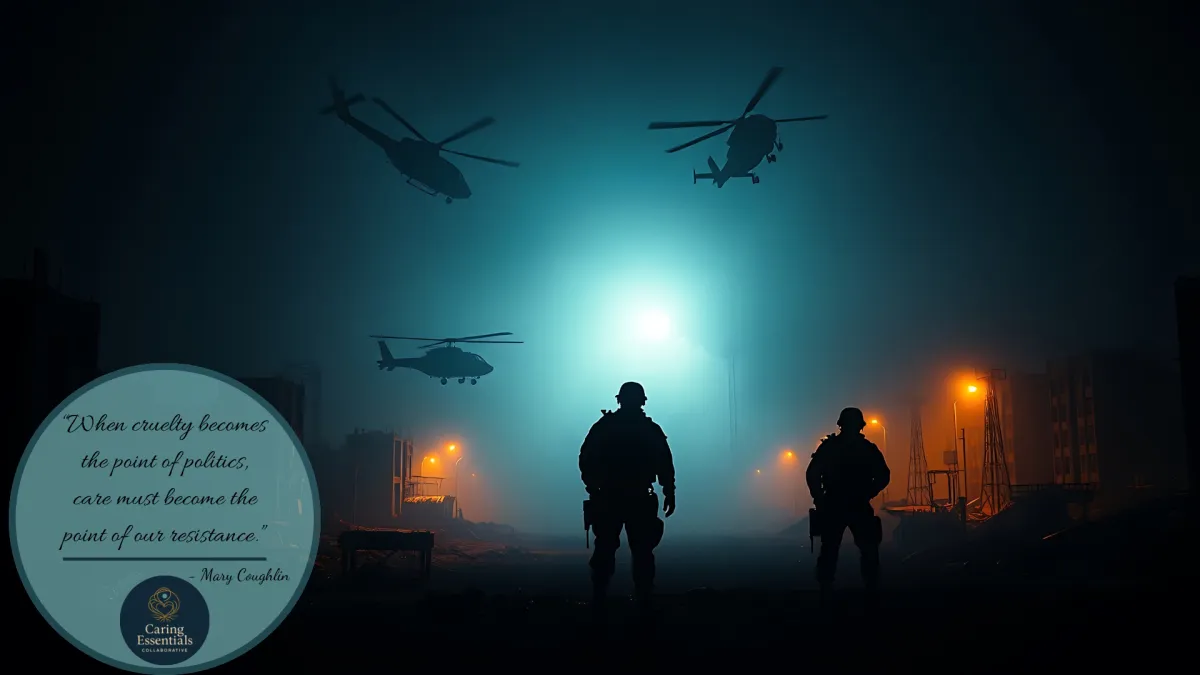
When Cruelty Becomes the Point
“When cruelty becomes the point of politics, care must become the point of our resistance.” - Mary Coughlin
When Cruelty Becomes the Point
When Cruelty Becomes the Point
When the Law Becomes the Weapon and the Courts Become the Last Line
A Trauma-Informed Lens on State Violence
Last week in Chicago, armed agents of the federal government broke into a residential building before dawn. They dragged families from their beds. They forced children out of their homes half-clothed. They filmed it. And then, in a grotesque inversion of justice, they reportedly used that footage for government promotional material. The Department of Homeland Security calls it enforcement.
I call it terror.
This is not a partisan statement; it is a human one. What happened in Chicago is not the rule of law, it is the performance of fear. A deliberate show of power designed to dehumanize, destabilize, and desensitize.
When Cruelty Becomes the Point
Let’s stop pretending this is about “border security” or “law and order.” This is about power as spectacle, and cruelty as policy.
Every administration reveals its moral DNA through how it treats the most vulnerable.
This one has chosen public spectacle as governance: terror in the dark of night, cameras rolling, children sobbing. It is not a failure of empathy; it is the weaponization of pain.
When the state inflicts harm so visibly, it sends a message to the rest of us: Stay silent. Stay compliant. This could be you.
Cruelty conditions the nervous system of a nation. It teaches us to dissociate — to numb ourselves into “normalcy.” But trauma-informed wisdom tells us what power already knows: when you terrorize enough people, you control the collective body.
When the Law Becomes the Weapon and the Courts Become the Last Line
The Fourth Amendment to the U.S. Constitution guarantees that “the right of the people to be secure in their persons, houses, papers, and effects, shall not be violated.” That promise does not end at a border crossing. It does not depend on paperwork. It is a recognition that the home, our most intimate boundary is sacred in both law and biology.
When ICE agents storm a building without a judicial warrant, when they batter down doors and terrorize sleeping families, they are not enforcing order. They are dismantling the very foundation of trust upon which democracy depends. They are saying: some people have no right to safety. Some people have no right to home.
But there is resistance. Across the country, civil-rights organizations are filing lawsuits that name these acts for what they are: gross violations of the Fourth Amendment.
In Los Angeles, a federal judge ruled that ICE’s home-raid tactics likely violate the Constitution.
In Chicago, attorneys from the ACLU and National Immigrant Justice Center have filed actions challenging warrantless arrests and raids like this one.
Cases such as Aguilar v. ICE and Gonzalez v. ICE have already forced reforms, affirming that the Constitution still draws a line even when power tries to erase it.
These suits matter. They’re not just legal maneuvers; they’re acts of collective regulation; a body politic trying to right itself after being thrown into shock.
A Trauma-Informed Lens on State Violence
From a trauma-informed perspective, a home raid is not an “operation.” It’s a systemic reenactment of trauma on children, families, and entire communities.
The home is a nervous-system anchor. When that boundary is violated, the body registers permanent threat.
Parents experience powerlessness and moral injury.
Children internalize terror as truth: I am not safe anywhere.
When this violence is sanctioned by the state, it sends a deeper wound through the national psyche, a rupture of trust in the very idea of protection.
Trauma-informed care teaches that healing requires safety, trust, and empowerment.
These raids annihilate all three.
The Trauma-Informed Counterpoint
The antidote to cruelty is not silence. It’s co-regulation. It’s naming what’s happening without flinching.
It’s refusing to let fear set the terms of our humanity. It’s remembering that safety is not a privilege, it is a human right.
That’s why the lawsuits matter. Every affidavit, every court filing, every protestor standing in the cold outside an ICE facility, these are trauma responses of a democracy fighting for regulation, not domination.
Cruelty may be the point of their politics.
But care, embodied, persistent, courageous care, must be the point of ours.
The Call to Witness and Act
This is where trauma-informed care meets civic responsibility.
Bear witness — Name what is happening.
Center survivors — Let their voices lead the narrative.
Support the defenders — ACLU, NIJC, immigrant justice groups on the ground.
Educate others — About the Fourth Amendment, about their rights, about the cost of silence.
Care audaciously — for one another, for democracy, for the idea that decency still matters.
History will remember this chapter not by how efficiently cruelty was carried out, but by how fiercely we refused to accept it.
Cruelty is the point of their politics. Care is the point of ours. And that is how the story must turn.
Mary
